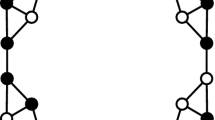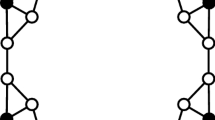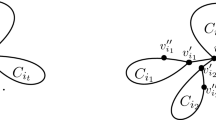Abstract
Let G be a graph such that the color of its vertices is white or black. A dynamic vertex coloring for G is defined as follows. One starts with a certain set of black vertices. Then, at each time step, a black vertex with exactly one white neighbor forces its white neighbor to become black. The initial set of black vertices is called a zero forcing set if by iterating this process, all of the vertices of G become black. The zero forcing number of G (denoted by Z(G)) is the minimum cardinality of a zero forcing set in G. In this paper, we study the zero forcing number of trees. Let T be a tree with at least two vertices. We show that \(\Delta (T)-1\le Z(T)\le r(T)-1\), where \(\Delta (T)\) and r(T) are the maximum degree and the number of pendant vertices of T, respectively. As a consequence, we obtain that \(Z(L(T))\ge Z(T)\), where L(T) is the line graph of T. We characterize all trees T such that \(Z(T)=\Delta (T)-1\). Finally, we study trees T with \(Z(T)= r(T)-1\).





Similar content being viewed by others
References
AIM Minimum Rank (2008) Special Graphs Work Group, Zero forcing sets and the minimum rank of graphs. Linear Algebra and its Applications 428:1628–1648
Amos D, Caro Y, Davila R, Pepper R (2015) Upper bounds on the k-forcing number of a graph. Discrete Appl Math 181:1–10
Barioli F, Barrett W, Fallat SM, Hall T, Hogben L, Shader B, van den driessche P, van der holst H (2013) Parameters related to tree-width, zero forcing, and maximum nullity of a graph. J Graph Theory 72:146–177
Burgarth D, Giovannetti V (2007) Full control by locally induced relaxation. Phys. Rev. Lett. 99:100501
Burgarth D, Giovannetti V, Hogben L, Severini S, Young M (2015) Logic circuits from zero forcing. Nat Comput 14:485–490
Davila R, Kenter F (2015) Bounds for the zero forcing number of graphs with large girth. Theory Appl Graphs 2:1
Edholm CJ, Hogben L, Huynh M, Lagrange J, Row DD (2012) Vertex and edge spread of zero forcing number, maximum nullity, and minimum rank of a graph. Linear Algebra Appl 436:4352–4372
Fallat SM, Hogben L (2007) The minimum rank of symmetric matrices described by a graph: a survey. Linear Algebra Appl 426:558–582
Haynes T, Hedetniemi S, Hedetniemi S, Henning M (2002) Domination in graphs applied to electric power networks. SIAM J Discrete Math 15:519–529
Lovasz L, Saks M, Schrijver A (1989) Orthogonal representations and connectivity of graphs. Linear Algebra Appl 114:439–454
Zhao M, Kang L, Chang G (2006) Power domination in graphs. Discrete Math 306:1812–1816
Acknowledgements
The author is grateful to the referees for their helpful comments.
Author information
Authors and Affiliations
Corresponding author
Rights and permissions
About this article
Cite this article
Oboudi, M.R. On the Zero Forcing Number of Trees. Iran J Sci Technol Trans Sci 45, 1065–1070 (2021). https://doi.org/10.1007/s40995-021-01112-5
Received:
Accepted:
Published:
Issue Date:
DOI: https://doi.org/10.1007/s40995-021-01112-5




